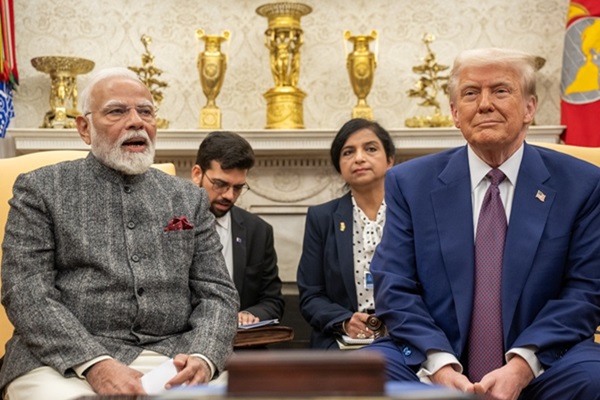.png)

Lt Gen Syed Ata Hasnain is a former Commander of India’s Kashmir Corps and Chancellor of the Central University of Kashmir.
August 10, 2025 at 11:53 AM IST
Indo-US relations have always been a dance of diplomacy, alternating between warmth and deep chill, never quite stagnant. The nature of the relationship is best described as dynamic — underpinned by shifting global realities, leadership changes, and national interests.
Few episodes capture the seesaw better than the arrival of the USS Enterprise in the Bay of Bengal in 1971, a not-so-subtle show of support for Pakistan during the Bangladesh Liberation War, which scarred Indian strategic memory for decades. Fast forward to 1998, and the Pokhran-II nuclear tests drew immediate US sanctions. And yet, just a decade later, India and the US signed a landmark Civil Nuclear Agreement, marking a new phase of trust. The rise of the Quad — India, US, Japan, and Australia — further anchored a shared commitment to Indo-Pacific security.
With the return of former President Donald Trump to the centre of US politics, questions loom large. Is America now recalibrating its global influence through economic means alone? Are tariffs Trump’s new warships, imposing pressure without deploying soldiers? In this evolving world order, where war is waged through supply chains and semiconductors, is the age of strategic partnerships giving way to transactional brinkmanship?
Protectionism as Power
Donald Trump’s worldview is shaped by economic nationalism — America must win, not just compete. His use of tariffs is not merely an economic tool but a method of asserting geopolitical dominance. Under the banner of “America First,” Trump recast trade as a zero-sum game, including with allies.
India was not spared, although perception prevailed that Trump 1.0’s excellent attitude towards India would ride out this rough. This approach isn’t new.
In his first term, Trump imposed tariffs on Indian steel and aluminium exports, and in 2019, revoked India’s preferential trade status under the GSP program, cutting off duty-free access for billions worth of Indian goods. These moves made it evident that, for Trump, trade was not a gesture of goodwill but a blunt instrument of leverage, even against partners.
With Trump 2.0 now in effect since January 2025, India must view the current tariff posturing not as a fresh provocation, but as the return of a tested strategy. The tariff war began some years ago, and this is its next chapter. What irks India is not just the action but the tone that India, a strategic partner, was being treated at par with adversaries.
For Trump, trade is power, and tariffs are the new currency of coercion. As India seeks a fair and reciprocal trade relationship, Trump’s approach raises concern; are geopolitical friendships secondary to trade surpluses? And what does this mean for strategic autonomy, a core tenet of Indian foreign policy?
A Changed World
Much has changed since Trump left office in 2021. The Ukraine war, now entering its 43rd month, has shattered assumptions about European stability. NATO has expanded; the US has committed over $100 billion to support Ukraine. Russia has been isolated economically but remains defiant.
This has recalibrated Washington’s foreign policy priorities. Containment of Russia has emerged as an overarching imperative, even at the cost of straining other partnerships. India, however, has refused to toe the line. Its oil imports from Russia surged, and it maintained strategic neutrality, voting cautiously in multilateral forums.
Our stance is rooted in realism. Russia remains a critical defence partner, and more importantly, a counterbalance against China, India’s foremost strategic challenge. The US, under Biden, had grudgingly accepted this. Trump is not so accommodating. There’s growing concern that Trump sees India as a “beneficiary,” not a peer, one that must now pay back in alignment and allegiance. Trump does not understand that beneficiary status can be accorded only if strategic partnerships are tested under stress and strain. At the first signs of challenge the US under Trump is testing a strategic partner.
So, is Trump trying to wedge India out to imbalance a potential triad of Russia-China-India?
Trump’s likely apprehension is that India may drift too close to the Russia-China axis, a strategic nightmare for Washington. While India is unlikely to enter any formal alliance with either but apprehensions exist and that is what India has to dispel. The perceived closeness, especially on platforms like BRICS, may raise flags in a Trump-led White House.
In Trump’s first term, he overlooked India’s $5 billion S-400 missile deal with Russia, avoiding CAATSA sanctions despite pressure from Congress. Was it flexibility, or indifference? Trump’s decisions often prioritise short-term advantage over long-term strategic alignment, making even close partnerships vulnerable to sudden shifts.
Trump may once again attempt to wedge India out of the Moscow-Beijing orbit, but likely through pressure, not persuasion. Those risks misread India’s position. New Delhi seeks strategic autonomy, not strategic ambiguity.
Pakistan Tilt
What has truly flummoxed Indian analysts is the recent warmth towards Pakistan from some US quarters. While not overtly hostile to India, this shift is symbolic. Given the US’ long and painful experience with Political Islam, and Pakistan’s duplicitous role in Afghanistan, any revival of ties seems counterintuitive.
Is this a pressure tactic? A signal to India that drifting too close to Russia may invite the revival of old US-Pakistan equations? Or does Trump still view Pakistan through a Cold War lens, a frontline state useful against larger threats. Perceptions were quite different in Trump 1.0. In a Reuters datelined January 1, 2018, Trump is known to have famously said: "They give safe haven to the terrorists we hunt in Afghanistan, with little help. No more!"
Trump also wrote on Twitter. "The United States has foolishly given Pakistan more than 33 billion dollars in aid over the last 15 years, and they have given us nothing but lies & deceit, thinking of our leaders as fools."
Either way, propping up Pakistan, especially given its economic collapse and dependence on China, seems more like short-term brinkmanship than a long-term strategy. It’s not just unproductive, it’s unwise.
Allies Under Pressure
Trump’s transactional approach hasn't been limited to India. Japan and South Korea, longstanding allies with US bases and joint commands, were frequently berated for not paying “their share” during Trump 1.0. This confounded many: why undercut alliances that cost less than they deliver?
India must be cautious here. The Quad, though not a military alliance, relies on shared values and strategic trust. If Trump’s erratic style returns, India may find itself rebalancing expectations from multilateral forums that were once seen as cornerstones of Indo-Pacific security.
Is this all a game of pressure tactics? Perhaps. But in geopolitics, perception often becomes policy — and consistent signalling is half the battle.
The Israel Factor
One underrated but important player in this matrix is Israel. India and Israel share deep defence and intelligence ties, with a growing tech partnership. Israel’s relationship with the US, particularly under Republican administrations, has remained steadfast.
Could Israel serve as a quiet mediator or stabiliser between India and a Trump-led US? Possibly. The Israel-US-India triangle, while informal, could play a useful role in maintaining continuity if things get turbulent. Backchannel diplomacy may matter more than ever.
India’s Posture: Strategic Patience
In this volatile environment, India appears to have adopted a time-tested strategy: wait, don’t yield, and don’t overreact. This posture reflects a maturing strategic culture that blends military confidence with diplomatic prudence.
The Armed Forces and diplomatic corps seem united in this. Observe, assess, but stay the course. Engagement with the US continues, but without overcommitment. Even politically the messaging seems sound so far. This is classic strategic autonomy at work — not non-alignment, but could be called ‘calibrated alignment’.
As seasoned diplomats often say: “When a bully is rampaging, the wise stay still.” That appears to be India’s current mantra.
So, what does the future hold for Indo-US relations?
If Trump returns, volatility may increase, but the structural foundations of defence and tech cooperation remain solid. The 2+2 dialogue, military exercises, intelligence sharing — these are too valuable to unravel after traveling this distance.
India must continue to diversify partnerships with France, Japan, Australia, Israel, and ASEAN so that in its strategic journey no single power can hold veto over its choices.
Strategic autonomy demands strategic clarity. That is India’s guiding light.
New Geopolitical Jungle
In conclusion, the world is undergoing a strategic realignment — new blocs, new wars, and new ways of projecting power. In such a scenario, India’s biggest strength is its ability to remain aligned without being beholden as also cooperative without being compromised.
Whether it is tariffs, strategic pressure, or temporary favouritism, India must continue building resilience — economic, military, and diplomatic. Geopolitics are never for the weak and the not so confident.
With or without Trump, the Indo-US relationship will remain critical, but not unconditional. And that’s exactly how it should be.




